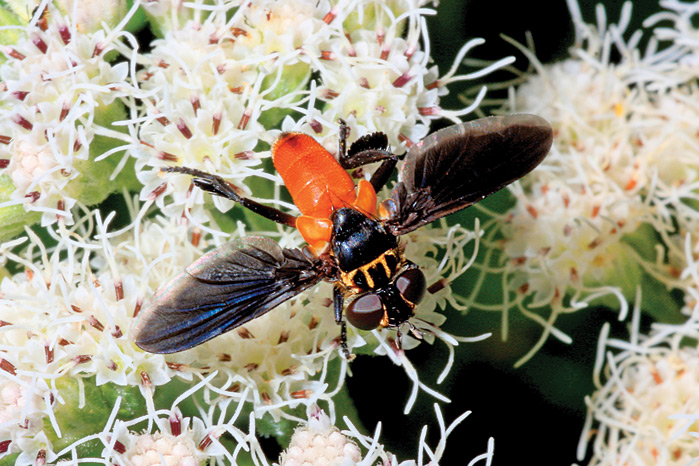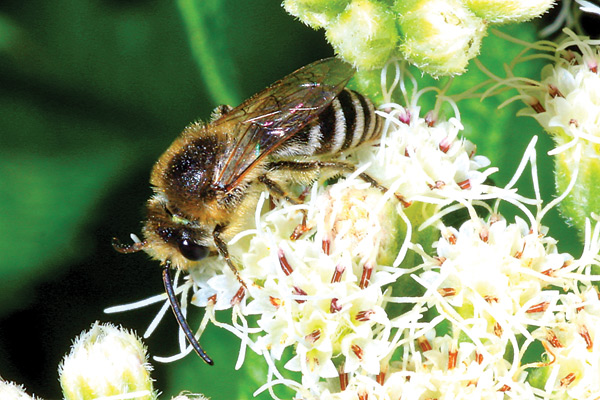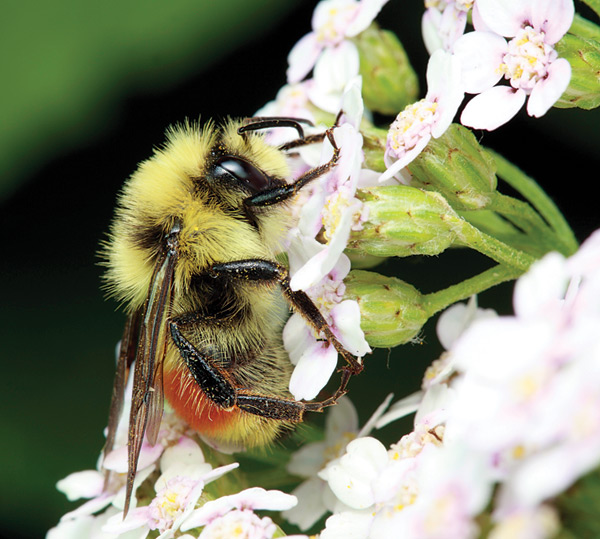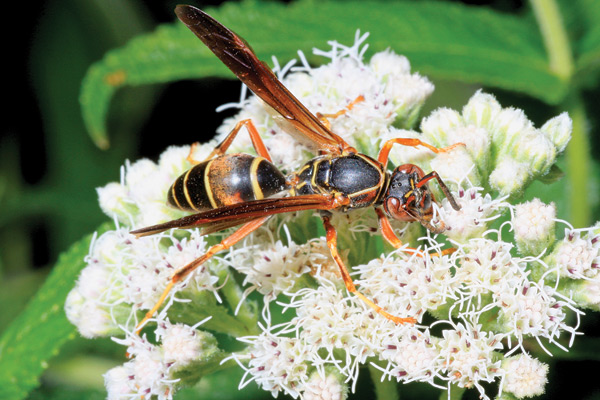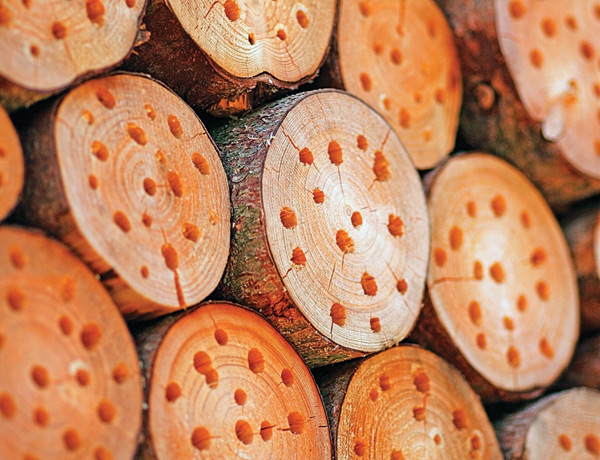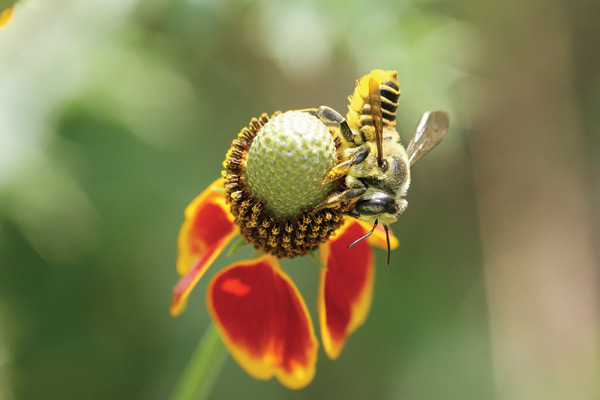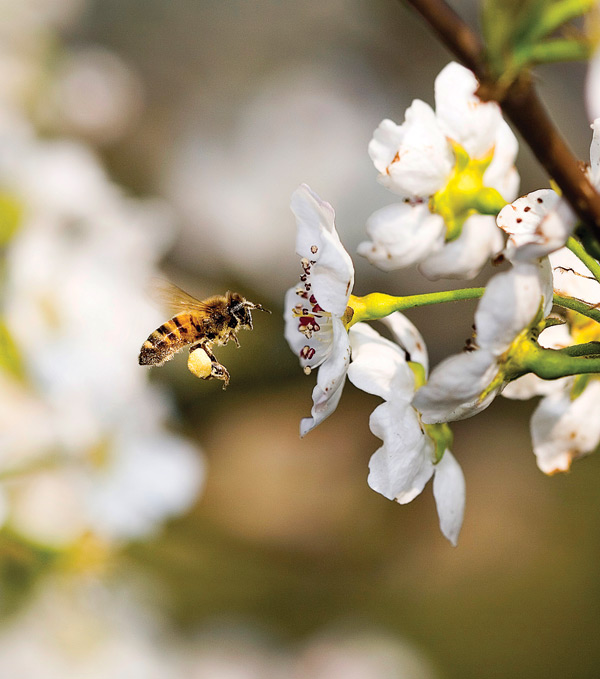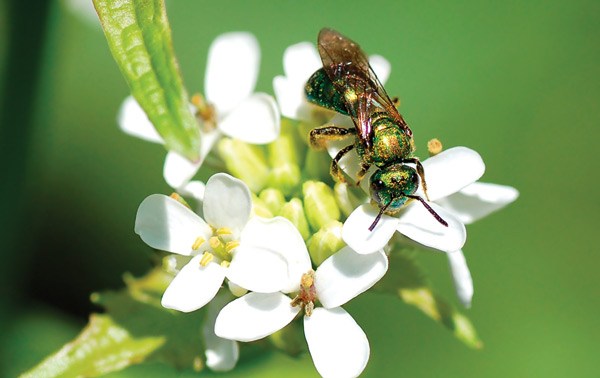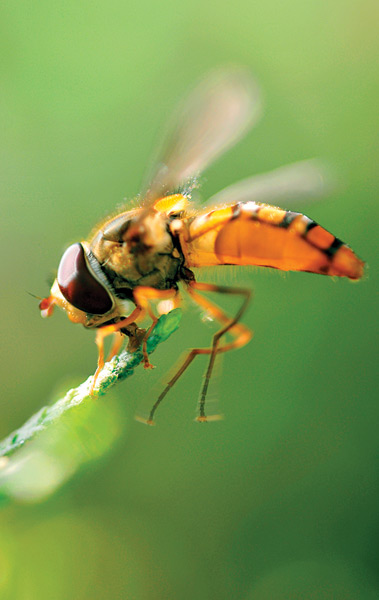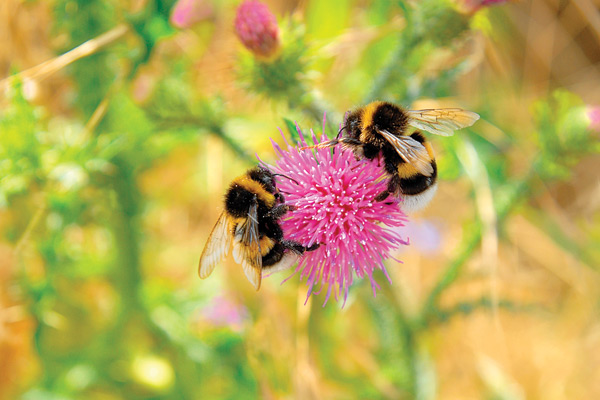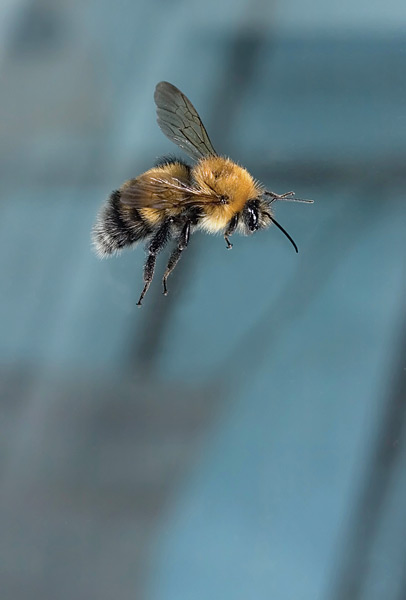Flight of the Bumblebee (and other pollinators)
In “Flight of the Bumblebee” Don Scallen says we owe a debt of gratitude to pollinating insects for keeping food on the tables of the human race!
Thirty years ago Mark van Trigt of Seventh Heaven apiary in Mono loaded the back seat of an old Volkswagen Beetle with cages of bees purchased from a beekeeper in Aurora. He and his brother and sister had plans. His dad had recently retired. Beekeeping seemed just the ticket to keep him occupied. So van Trigt and his brother were now on their way to Owen Sound, their home at the time, with a stash of bees.
Shortly into the three-hour trip, some of the bees, chafing at their confinement, managed to slip out of the cages. The interior of the Beetle was soon abuzz. Van Trigt remembers thinking, “Omigod, what are we doing?”
In a testament to great concentration, van Trigt managed to negotiate his way home without incident. He breathed a sigh of relief, cleared the car of bees and introduced them to his father. It turned out that though his dad was fascinated by the bees, he had little inclination to take care of them. That task fell to van Trigt and his sister. It was the beginning of a labour of love that eventually brought van Trigt and his bees to the meadows of Mono.
Beekeepers like van Trigt are the latest in a lineage of honeybee devotees that stretches back into the mists of time and spans the globe. And like most who work closely with the world’s most celebrated insects, van Trigt is passionate about his bees.
“When I’m out in my bee yard – and it can be very hard work, very hot sometimes – the bees just make me so happy. I love the fact that they’re living and thriving and they’re doing us such a service.”
The wild Bee reels from bough to bough
With his furry coat and his gauzy wing,
Now in a lily cup, and now
Setting a jacinth bell a-swing,
In his wandering.
Oscar Wilde, Her Voice
Like Pooh Bear most of us equate honeybees with the sticky sweetness of honey and little else. We should pause and consider where that honey comes from. In her book Nature’s Little Wonders, Candace Savage quotes the almost unbelievable statistic that “one pound of honey represents the sweetness of about ten million blossoms.”
On average, Dufferin beekeepers harvest about 115 pounds of honey per year from each of their hives. Exceptional hives sometimes produce an incredible 300 pounds or more. I’ll leave you to calculate the number of blossoms that represents!
Using magical alchemy to transform nectar into honey isn’t all that honeybees do. They are also interested in the pollen of those numberless flowers offer, for they feed it to their brood. And as they collect the pollen, they serve inadvertently as the flowers’ sexual proxies, transferring pollen from male stamens to female pistils.
However, honeybees are far from alone in providing this vital pollination service. Like most of us, honeybees are relatively recent arrivals to North America. They were passengers aboard the wooden sailing ships of European colonists. As they spread across the continent, the native people referred to them as “white man’s flies.” No doubt their expansion was assisted by the successful colonization of the new land by some of their fellow travellers, including dandelions and clover.
Prior to the arrival of the honeybee, a host of native bees and other insects provided the essential pollinating services. These insects continue to labour in relative obscurity for our benefit and that of natural ecosystems. They include the plush toys of the pollinator world, the furry bumblebees that, like honeybees, enjoy a communal, co-operative lifestyle.
Hundreds of other bees also inhabit our hills. Most are solitary, independent creatures who don’t depend on the intricate support structure of a hive to exist. They are a colourful and fascinating lot and include mining bees and mason bees, carpenter bees and sweat bees, leafcutter bees and long-horned bees.
Beyond bees is a menagerie of other local pollinators. Wasps, reviled by many for their stings, are major pollinators; flies are as well, including the common bluebottle fly. Many beetles forage atop wildflower heads and they too are worthy of acknowledgement. Butterflies also contribute to pollination as they sip nectar, and their nocturnal counterparts, the moths, also play a role.
There has been a recent awakening here and throughout the world as to the importance of all of these pollinators. About three-quarters of the world’s flowering plants rely on them. They pollinate most of the fruits and vegetables that we enjoy. Pollinators are also vital for the seed production of such crops as alfalfa and clover that are used as forage for cattle.
Beyond this, the industrious pollinators knit together the fabric of the environment. Trees, shrubs and wildflowers depend on them to produce fruit and seed – bounty that then feeds all manner of birds, mammals and other insects. A decline in pollinators would have dire consequences for our local biodiversity.
Given their tremendous importance to our food supply and ecosystem, it is no wonder that stories of recent honeybee decline have caught public attention. Much ink has been spent warning of imminent doom due to something called “colony collapse disorder.” Books such as Fruitless Fall and A Spring Without Bees have hit the shelves. Lesser known, but perhaps just as potentially alarming, is the perceived decline in native pollinators, including bumblebees.
At a Dufferin County Beekeepers Association meeting this spring, I met an engaging group of men and women who, like Mark van Trigt, share a passion for honeybees. Their good-natured banter seemed somewhat out of place in light of the bad news in the press.
It was not that honeybee decline was unknown to them. Winter mortality, a major measure of honeybee health, has apparently increased in Dufferin as it has elsewhere. Whereas 15 per cent of bees could be expected to succumb during the winter in years past, the “new normal” appears to be more like 30 per cent, according to some club members.
Honeybees, like people, are victims of a variety of diseases and parasites. Some of these pathogens probably accompanied them to the new world long ago. But others are of more recent origin, and like the human afflictions of AIDS or West Nile, have arrived from off-shore. One of the latest, first appearing in Dufferin County about 1985, is the ominously named Varroa destructor mite. This pinhead-sized arachnid pierces honeybee exoskeletons, sucking up body fluids and passing on lethal viruses.
The Dufferin County Beekeepers Association isn’t going to roll over in the face of Varroa destructor and other honeybee threats. In fact, association president Darcie McKelvey suggests that “Newcomers have been attracted to the field in light of all the information about colony collapse disorder because of their concern about pollinators. Yes, honeybees are somewhat in trouble, but the story is far from over.”
The Dufferin beekeepers are actively seeking answers to strengthen the health of their hives. The speaker on the evening of my visit to the beekeepers’ meeting was Glen Ackroyd, a major honey producer formerly of Caledon East and now resident in Tara, Ontario. He stressed that, “Research appears to indicate that nutrition is key to the health of hives. Controlling Varroa mites and providing a well-balanced diet are important steps towards successful honey production.”
Various chemical and mechanical means are available to control the mite. What is still evolving is the optimum mix of such controls, a regimen that preserves the health of the hive without tainting the honey supply. Van Trigt contends that Varroa and other problems are completely manageable if honey producers and beekeepers would only put “bees first.”
Van Trigt’s winter mortality over the last three years – the very years of colony collapse disorder alarm – have been astonishingly low, at 5 per cent or less. Like Glen Ackroyd, he sees a balanced diet as one of the keys to success.
He assails the big beekeeping operations in the United States who practise “pollination for hire,” trucking their bees from state to state to pollinate monocultures – almonds in California in the spring, for example, perhaps apples later in New York, and then on to Maine to pollinate blueberries. Like people, he says, bees need diversity in their diet. The wildflowers, trees and shrubs of Dufferin County satisfy this need.
In van Trigt’s view, when bees become mere units of industrial production, health problems ensue. Too many beekeeping operations “strip the bees of every drop of honey they can get out of them,” he says, “and then feed them back a junk food diet of corn syrup and a pollen-substitute concoction made up mostly of soy flour.”
Van Trigt eschews advice to offer that “energy-boosting” diet to his bees in the spring. Instead, if their spring honey stores are low, van Trigt gives the bees back some of the honey he harvested in the fall. Honey, after all, is a honeybee’s natural food.
As much as he loves honeybees, Mark van Trigt is also taken by the various wild bees that visit the flowers around his home in Mono. And he admits that honey bees “don’t fill every niche in pollination.” That is why attracting native bees will be front and centre at Caledon Farm, an intriguing enterprise that has hired van Trigt as a pollination consultant.
This farm, located on Main Street between Orangeville and Alton, produces fruit and vegetables for Toronto restaurants and specialty grocers. According to part owner David Warburton, the practices on the farm are guided by the principles of permaculture.
Permaculture seeks to “replicate complete environmental systems,” says Warburton. Using nature as a model, the farm will feature a wide diversity of crops, and compost and manure will take the place of artificial fertilizers as much as possible. Every effort will be made to establish natural, sustainable interactions between animals, insects and plants to create a functioning ecosystem.
Pollination is a fundamental way to strengthen these natural interactions. This is where van Trigt’s expertise comes in. He will help Warburton establish an apiary on site and will endeavour to make the farm a haven for wild pollinators as well.
Bumblebees will be needed to pollinate the tomatoes. Unlike honeybees, bumblebees will readily enter the hoop houses where the tomatoes will be grown. Bumblebees are also far better at pollinating tomatoes than honeybees. They use a process called “sonification,” basically shaking the dickens out of a flower to release its pollen.
Van Trigt hopes that surveys of the farm site will reveal enough resident bumblebees to do the job. Though it is possible to buy commercially reared bumblebees, van Trigt would rather not. Such bumblebees can carry disease and parasites that may infect wild populations.
Van Trigt will also survey the site for other native bees and “try to accommodate them by providing them with the homes, plants and building materials that they need.” Mason bees, for example, use mud to build the cells that house their eggs and larvae. So areas of clay soil will be left open for their benefit.
Van Trigt laments that even gardeners who appreciate native pollinators often cover all bare patches of ground with mulch, denying the mason bees their building material.
“Leafcutter bees, also notable pollinators, have specific plants that they really like for rolling a leaf-tube to lay an egg inside,” says van Trigt. Roses are favourites and will be planted at the Caledon farm to furnish the leaves necessary to make leafcutter bees happy.
Because leafcutters make small oval holes in rose leaves, van Trigt understands why rose-loving gardeners might rush for the insecticide when they see evidence of the bees’ work. But he insists such reaction is amiss. Leafcutter damage is merely cosmetic and no danger to the health of the roses.
Mark van Trigt will also attract native bees to the farm by providing them with accommodation. Mason bees, leafcutter bees, orchard bees and others nest in holes in wood. Homes will be provided by drilling holes in chunks of non-pressure-treated wood with little roofs to shed the rain. They’ll be elevated about three or four feet and facing southeast to catch the morning sun. It is hoped that these bee-friendly practices – which can easily be copied in your backyard – will become an important part of the farm’s permaculture practice.
That which is not good for the beehive
cannot be good for the bees.
Marcus Aurelius, Meditations
Victoria McPhail of Pollination Guelph is engaged in a project that also seeks to attract and sustain pollinators, though on a grander scale than the one underway at Caledon Farm.
McPhail is a natural heritage technician with Credit Valley Conservation. In her off-hours she wears another hat as director of publicity and outreach for Pollination Guelph, an organization “dedicated to the conservation and development of pollinator habitat for current and future generations.”
The creation of “Pollinator Park” on an old landfill site in northeast Guelph currently occupies much of this organization’s energy. It will contain the “first large-scale planned pollinator plantings anywhere,” says McPhail.
She says a primary goal of the park is to “educate city officials and people in the community about the need for pollinator habitat and protecting pollinators.”
Pollinator Park will be founded on principles that can be duplicated on a smaller scale by anyone on their farms and in their gardens or natural areas. There will be a wide diversity of native flowering plants – shrubs, trees and wildflowers to meet the needs of honeybees and the native pollinators. Flowers of many different shapes and colours will aim to satisfy the needs of various pollinators. For example, with their short tongues, bumblebees need flowers with shallow “nectar wells,” because they can’t reach inside the tubular blossoms favoured by their long-tongued cousins.
The flowers will be chosen to bloom from early spring into the fall, ensuring a constant supply of pollen and nectar for the winged throngs. And flowers of the same species will be planted in “bundles” or patches to act as visual beacons to the pollinators.
What won’t be found in Pollinator Park are the hybridized exotic annuals so often the flowers of choice in suburbia. Most of those – impatiens, petunias, marigolds and the like – are about as appealing to pollinators as silk flowers. They may be pretty, but they contribute little or nothing to the health of the environment.
Like Caledon Farm, Pollinator Park will also provide the other things pollinators need, says McPhail. “We’ll put up nest boxes for twig-nesting bees and leave areas of exposed soil for ground-nesting bees, for example.”
The end result, and a goal all of us can embrace in our own patches of earth, will be “an increase in fruit and seed production helping the whole food chain. This will be like a wildlife reserve where birds come in and eat the insects and seeds. It will become a fully functioning ecological community supporting all different types of animals and plants.”
McPhail envisions a future when owners of properties large and small will consciously consider pollinators in their landscaping plans. She looks forward to a network of “green backyards that will enable bees to travel from place to place within our towns and cities.” It’s a future worth aspiring to. Creating pollinator habitat in our own yards and public spaces is one of the easiest and most rewarding ways that individuals and communities can help heal nature.
It is also a fascinating way to bring natural diversity to our doorsteps. I predict that “pollinator watching” will grow in popularity over the coming years, just as butterfly and dragonfly watching recently has. Watching the pollinators is like bird watching, though admittedly on a rather Lilliputian scale! Pollinators are as beautiful as birds and immeasurably more diverse.
Late summer finds me sitting for long periods of time in front of a wildflower called boneset in my backyard. The pollinator traffic is constant – honeybees, bumblebees, leafcutter bees, wasps, beetles and a host of other tiny fliers that I have yet to identify.
For me, watching pollinators is a feel-good experience, akin perhaps to the ineffable happiness that Mark van Trigt feels when he is working with his honeybees. Maybe these positive feelings are due to “biophilia,” a term coined by the great naturalist E.O. Wilson to describe an instinctive bond between humans and nature.
Welcoming the vital pollinators into our midst can only strengthen this bond.
More Info
- Pollination Guelph
- Pollinator.org
- Pollination Canada
- The Xerces Society for Invertebrate Conservation
- Instructions on how to build nest boxes for native bees (download PDF here)
- Notes from the Wild, Don Scallen’s blog

